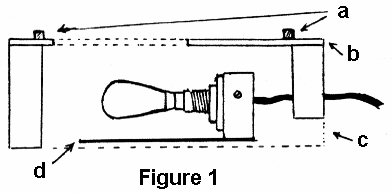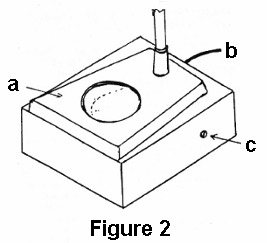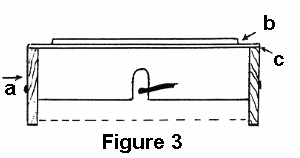 FIGURE 1. SECTION OF LIGHT BOX FROM SIDE
FIGURE 1. SECTION OF LIGHT BOX FROM SIDEBy William Ells
Coniferae, Walnut Tree Lane, Loose, Maidstone, Kent.
ME15 9RG, UK.
Many modern microscopes have a base designed to be used with transmitted light. As mine was provided with incident lighting (top) only, I made up the box shown in the drawing. Exact dimensions are not given, as the box must be made to suit the microscope or materials available. My box is about 8 inches square and 2.75 inches high. I used a 15 watt 240 volt pygmy type lamp in a medium bayonet holder and cut an opal perspex disc to replace the reversible black and white opaque disc when using the transmitted light base. A useful addition would be a switch either mounted on the box or a press table lamp type inserted in the flex.
 FIGURE 1. SECTION OF LIGHT BOX FROM SIDE
FIGURE 1. SECTION OF LIGHT BOX FROM SIDE
Key:
a) Wood strips to locate base of microscope
b) Hardboard top
c) Heat outlet
d) Metal sheet to reflect light and heat
 FIGURE 2. VIEW WITH MICROSCOPE BASE IN
POSITION
FIGURE 2. VIEW WITH MICROSCOPE BASE IN
POSITION
Key:
a) Microscope base
b) Wire to mains
c) Light batten fixed each side with single
screw to tilt for changing lamp
 FIGURE 3. REAR OF BOX
FIGURE 3. REAR OF BOX
(showing gap for heat outlet and slot for wire to allow light
batten to tilt)
Key:
a) Wood sides of box
b) Wood strip to locate base of microscope
c) Hardboard top
Comments to Bill Ells welcomed.
Editor's note:
For safety it is recommended that a knowledgeable person is
consulted if you are unfamiliar with wiring mains voltage
equipment, particularly with regard to earthing any metal parts
of the light box.
Acknowledgment
The Micscape Editors thank William Ells for contributing this
practical tip, which first appeared in Balsam Post, No. 10, 1988,
the magazine of the 'Postal Microscopical Society', UK.
Please report any Web problems
or offer general comments to the Micscape Editor,
via the contact on current Micscape Index.
Micscape is the on-line monthly
magazine of the Microscopy UK web
site at Microscopy-UK